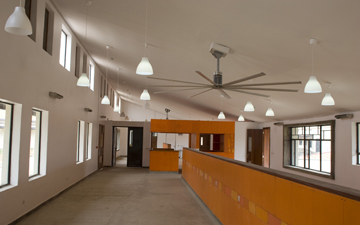Fans Help Prevent Disease at Rwanda Clinic

In the northern mountainous region of Rwanda, a new health clinic faces a health concern common among African clinics: the spread of disease within the facility.
Architects on the project used design as a tool to help combat the spread of disease by introducing natural ventilation into the facility to kill airborne pathogens associate with tuberculosis, a particularly rampant disease in the region.
The clinic opened at the beginning of the year in partnership with the government, the ministry of health, Partners in Health and the Clinton Foundation.
The six-ward clinic, which is not on the electrical grid and runs on generators, solar and hydroelectric power, is built of masonry and steel, according to officials from Big Ass Fans, the Lexington, Ky.-based manufacturer whose fans are employed at the facility.
The facility design features outdoor walkways, alfresco waiting rooms and large windows strategically placed on opposing walls to help with air circulation.
To assist with natural ventilation, Big Ass Fans were installed to pass the air over UV lights, killing airborne pathogens. 

“Using Big Ass Fans allows us to have only one or two fans per ward, running them at speeds low enough that it will not make people feel cold,” said Garret Gantner, project architect with the MASS Group, a firm consisting of students from the Harvard University Graduate School of Design, in collaboration Boston-based healthcare non-profit Partners in Health.
The fans operate silently without compromising the volume of air movement, which Gantner said was “the most important factor in preventing disease transmission.”
Seven of the manufacturer’s Isis fans were installed at the clinic to ventilate the space and optimize airflow rates using a low volume of energy.
The fans, which run on hydroelectric power, will be able to run 24 hours a day when the electrical grid is operable to the clinic, providing the optimal number of air turnovers without disrupting the comfort of patients and staff, said officials from the company.
“One added bonus was watching the bewilderment of the site crew as the first fan was being assembled,” said Gantner. “Some people thought we were trying to build a helicopter.”
